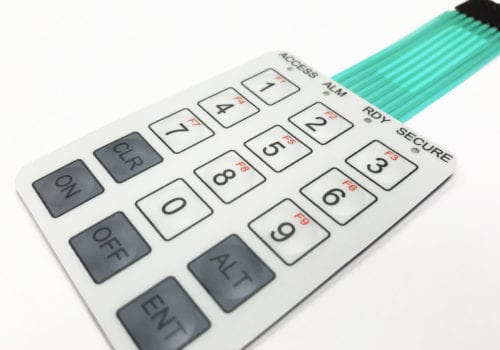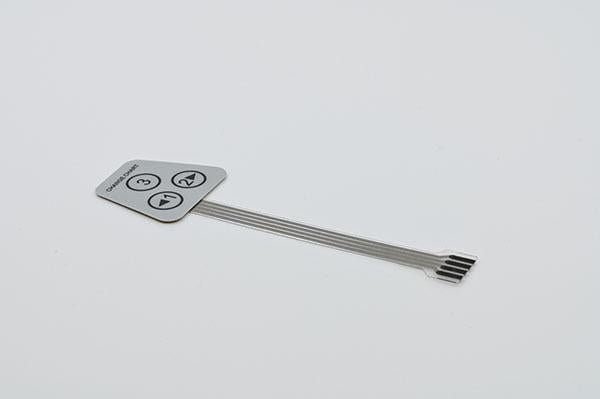The Role of a Membrane Switch in Modern Touch Interfaces and Controls
The Role of a Membrane Switch in Modern Touch Interfaces and Controls
Blog Article
How Membrane Switches Contribute to the Longevity of Electronic Control Panels
Membrane switches play an essential function in improving the toughness of digital control panels, mainly through their multi-layered building which supplies reliable protection versus environmental variables such as wetness and dust. This style not only decreases the threat of circuit damages and rust but additionally advertises ease of maintenance as a result of its seamless surface. The absence of moving parts considerably lowers the chance of mechanical failures, making membrane switches over suitable for requiring applications. The effects of these functions prolong past simple security, increasing concerns regarding their more comprehensive effect on performance and customer experience.
Interpretation of Membrane Buttons

Membrane switches are created to be slim and lightweight, making them appropriate for applications where room is restricted. They can be manufactured in different forms, sizes, and shades, offering flexibility in design that satisfies visual and practical requirements. Furthermore, membrane layer buttons can include numerous technologies, such as tactile comments and LED signs, improving customer experience.
As a result of their building and construction, membrane layer switches are frequently resistant to dust, moisture, and general wear, contributing to their resilience sought after atmospheres. Their seamless design not only helps with very easy cleaning yet additionally minimizes the threat of mechanical failing, making them a recommended choice for makers looking for reputable customer interfaces in their digital control board.
Security Against Environmental Factors
The layout of membrane layer changes inherently provides a level of defense versus various environmental aspects, which is essential for maintaining functionality in difficult problems - Membrane Switch. These switches are normally constructed with layers of flexible products that protect internal components from dampness, dirt, and pollutants. By enveloping the wiring, membrane layer changes minimize the threat of short circuits and rust, which can dramatically impair performance
In addition, using durable adhesives and sealants during manufacturing enhances their resistance to ecological obstacles. Membrane buttons can withstand exposure to chemicals and solvents, making them ideal for sectors such as food processing and health care, where health and sanitation are critical. Their seamless surface design likewise protects against the buildup of dirt and bacteria, assisting in simpler cleansing and maintenance.
Temperature level variations are another ecological worry, and membrane switches are engineered to function properly across a wide variety of temperatures (Membrane Switch). This adaptability makes sure that control board stay functional in various settings, from commercial settings to consumer electronics
Effect on Individual Interaction
Customer interaction with digital control panels is substantially influenced by the style and functionality of membrane switches. These buttons offer a tactile interface that improves the overall user experience, enabling intuitive navigating and control. Their responsive nature makes certain that users get prompt responses upon activation, which is essential for tasks needing precision and efficiency.
In addition, the smooth surface area of membrane layer switches assists in very easy cleaning and upkeep, advertising user self-confidence in the integrity of the user interface. This cleanliness is specifically crucial in settings where health is paramount, such as clinical or food processing setups. Furthermore, the small and light-weight layout of membrane layer changes adds to the visual appeal of control panels, urging customer interaction through a modern-day and sleek appearance.
Furthermore, the combination of visual elements, such as published icons and backlighting, aids individuals promptly determine features, lowering the finding out contour connected with new devices. Because of this, individuals can run devices better, bring about boosted productivity and complete satisfaction. In recap, membrane layer switches play a pivotal function in boosting customer interaction by combining functionality, aesthetic appeals, and simplicity of usage, inevitably causing enhanced functional efficiency.
Design Flexibility and Personalization
Layout adaptability and modification are necessary facets of membrane layer switches, making it possible for manufacturers to customize electronic control board to certain applications and user needs. This versatility permits the combination of different style aspects, such as colors, graphics, and structures, which can boost the visual appeal and customer involvement of the control board.
Membrane switches can be personalized in size and shape, suiting a wide variety of gadgets and applications, from industrial machinery to consumer electronic devices. This adaptability makes sure that producers can produce instinctive interfaces that align with user expectations and operational needs. In addition, the capacity to incorporate one-of-a-kind features such as backlighting or tactile comments additionally boosts functionality, permitting for a more interactive experience.
Furthermore, the production procedure for membrane layer changes sustains the rapid prototyping of designs, allowing producers to other repeat and fine-tune their principles quickly. his response This capability not just accelerates the advancement timeline however likewise guarantees that the last product satisfies certain practical and visual requirements.

Cost-Effectiveness and Durability
Cost-effectiveness and durability are considerable advantages of membrane buttons, making them an attractive option for manufacturers and end-users alike. These buttons are commonly much less costly to produce than conventional mechanical switches, largely as a result of their streamlined manufacturing processes and the lowered number of components called for. This expense advantage extends not just to preliminary manufacturing yet likewise to long-term functional costs, as membrane buttons usually call for much less maintenance and have a reduced failure price.
Additionally, the longevity of membrane layer changes adds to their total value. Constructed from sturdy materials, they are immune to environmental factors such as wetness, dust, and chemicals, which can bring about premature wear in various other switch kinds. The absence of relocating parts decreases mechanical failure, allowing membrane switches over to keep capability over extended periods.
This longevity is specifically helpful in applications needing constant performance under demanding conditions, such as clinical tools and industrial equipment. Eventually, the combination of cost-effectiveness why not try here and durability makes membrane layer changes a financially viable option for manufacturers, supplying reliable options that withstand the test of time while maximizing monetary considerations.
Final Thought
To conclude, membrane buttons dramatically enhance the resilience of digital control panels through their robust building and construction and safety features. By efficiently securing circuitry from ecological threats and minimizing the risk of mechanical failure, these switches make sure regular efficiency sought after applications. The seamless layout advertises hygiene and convenience of upkeep, while customization options enable tailored services for different needs. In general, membrane switches represent a trustworthy and economical selection for improving the durability and functionality of electronic control systems.
Report this page